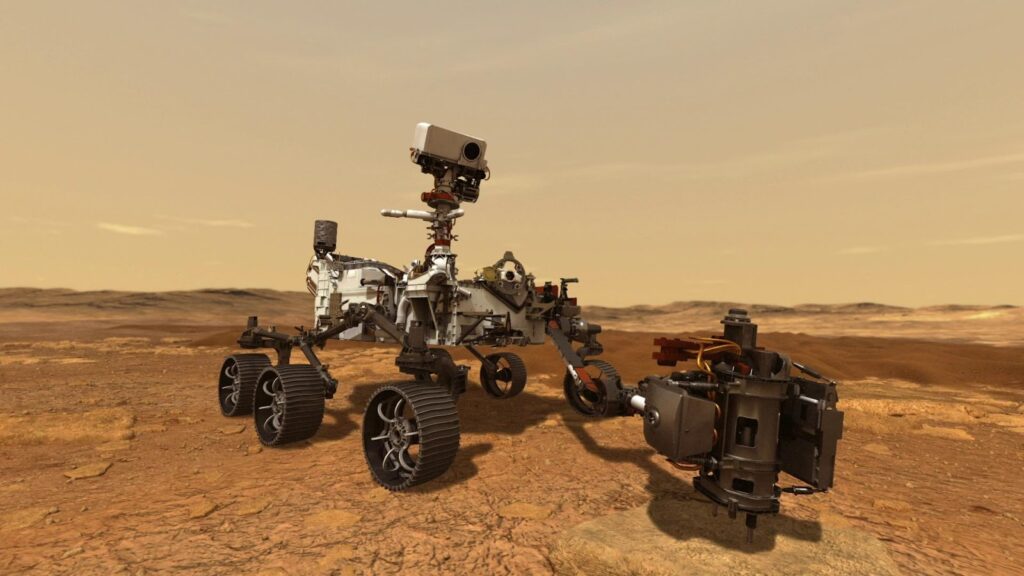Marcus Mount — Deer Valley High School, Antioch, CA, USA
When we think about it, space exploration is arguably humanity’s most exciting and monumental work. We owe much of our understanding of the universe to two forms of exploration — robotic missions and human missions. They each have pros and cons, and scientists are still arguing which is superior. Robotic exploration costs less to deploy and is safer, while human exploration is more flexible and imaginative in space.
Robotic Exploration
One of the main advantages of robot exploration is its cost. Sending robots into space is much cheaper than sending human beings. Robots don’t need food, air, water or shielding against the harsh environments of space the way humans do. Missions like the Mars rovers Spirit, Opportunity and Perseverance have been at work for decades for a fraction of the cost of a human mission (see Figure 1). With their lower costs, space agencies now can afford to launch several robotic missions to explore different parts of the solar system simultaneously.

Fig. 1 The Mars Perseverance rover (artist’s conception) landed on Mars in February 2021 and is currently exploring the planet with multiple advanced sensing capabilities. (Credit: NASA/JPL)
The use of robots also helps prevent the risk to human life. Space is extremely dangerous. Astronauts are subjected to radiation exposure, microgravity, and machinery failures. With a robotic mission, if things go wrong, the worst that can happen is the loss of the robot itself. But if a manned mission fails, people die. The Challenger and Columbia tragedies serve as reminders of the inherent risks in going into space. Robotic missions allow scientists to visit other worlds without putting human lives in jeopardy.
While there are advantages in robotic missions, there are also serious drawbacks. Bots are only as smart as the technology that drives them. They can only follow pre-set orders or respond using basic AI. A bot may not adapt if something unexpected happens. For example, the Spirit rover got stuck in Martian soil in 2009, and there was no way to unpin it. However, a human astronaut could have simply stepped outside and fixed the problem. Humans are better at quickly making decisions, improvising, and fixing unforeseen issues in situ.
Human Exploration
One of the most powerful advantages of human exploration is the opportunity for advancing meaningful scientific studies. Robots may be able to collect samples and analyze them using equipment aboard the rover, but humans can inspect, feel and experiment with materials in ways robots can’t. The astronauts on the Moon would immediately be able to tell which rocks were most scientifically worthy of being sent back to Earth for intensive examination (see Fig. 2). That’s the sort of thing robots cannot do. Moreover, astronauts can also repair and replace equipment in space. The Hubble Space Telescope, for instance, was serviced several times by astronauts, allowing it to continue to operate for decades.

Fig. 2 Image from the Apollo 16 mission to the Moon in 1972 showing the Lunar Roving Vehicle (LRV) in the background, an astronaut and lower portions of the Apollo Lunar Module to his right, along with the Lunar Ultraviolet Camera/Spectrograph (UVC) in the foreground that was successfully deployed. (Credit: NASA)
But human exploration is fraught with serious problems. Long-duration space travel is not only expensive and dangerous, but bad for the human body. Muscle and bone loss affects astronauts at the International Space Station (ISS) in microgravity. Issues with lag times between telemetry transmission and reception pose another major concern. These issues are compounded by radiation hazards beyond the protective magnetic field of Earth (for any trip to the Moon, Mars, or selected asteroid).
Conclusions
In summary, both robotic and human space exploration come with their own advantages and disadvantages. Robots are inexpensive, safe and dependable for most missions. But they lack the adaptability and intellect of human space travelers. Human missions, by contrast, are more efficient for problem solving and scientific discovery, but are also more expensive and risky. The reality is you will do both in the future of space exploration, with robots leading the way for humans to follow. The human repair of the Hubble Space Telescope is but one example of human-robotic synergies. Together, robotic and human explorers can all help to expand knowledge of our universe.
Marcus Mount wrote this essay as a 10th grade student at Deer Valley High School in Antioch, CA, USA. He credits his physics and astronomy teacher, Jeffery Adkins, as his reference.
